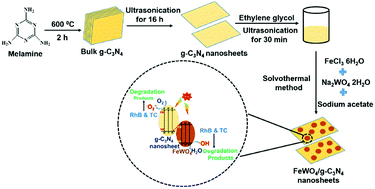Construction of in situ self-assembled FeWO4/g-C3N4 nanosheet heterostructured Z-scheme photocatalysts for enhanced photocatalytic degradation of rhodamine B and tetracycline†
Abstract
Although photocatalytic degradation is an ideal strategy for cleaning environmental pollution, it remains challenging to construct a highly efficient photocatalytic system by steering the charge flow in a precise manner. In this work, a novel, highly efficient, stable, and visible light active hybrid photocatalytic system consisting of FeWO4 and g-C3N4 nanosheets (CNNs) has been successfully prepared by an in situ self-assembly solvothermal approach. Several characterization techniques were employed to study the phase structures, morphologies, optical properties, surface composition and chemical state of the as-prepared samples. SEM and TEM results demonstrated that the FeWO4 nanoparticles are uniformly dispersed on the surface of CNNs with a diameter of about 10–20 nm, which could provide maximum interfacial contact and a synergistic coupling effect between FeWO4 and CNNs. XPS and FTIR results confirmed that there was strong electrostatic interaction between FeWO4 and CNNs, suggesting the formation of heterojunctions between them. In addition, UV-DRS and PL spectroscopy revealed that the FeWO4/CNN composites exhibited increased visible light absorption and improved charge generation/separation efficiency. As a result, the photocatalytic activity of the FeWO4/CNNs was enhanced in comparison with pure FeWO4 and CNNs for rhodamine B (RhB) and tetracycline (TC) degradation under natural sunlight irradiation. The photocatalytic efficiency of the optimal FeWO4/CNN composite (10 wt% FeWO4/CNNs) for the degradation of RhB (TC) was about 13.26 (4.95) and 86.2 (31.1) times higher than that of pure FeWO4 and CNNs, respectively. Meanwhile, the 10 wt% FeWO4/CNN sample exhibits good photocatalytic stability in recycling experiments. The enhanced photocatalytic activity may be attributed to the formation of the Z-scheme system between FeWO4 and CNNs, effectively prolonging the lifetime of the photoexcited electrons generated by CNNs and the photoexcited holes generated by FeWO4, which was subsequently confirmed by the active species trapping experiments and the calculation of relative band alignments. This work opens up a new feasible avenue to synthesize visible light active Z-scheme photocatalysts for application in energy production and environmental remediation.

- This article is part of the themed collection: Photocatalysis and Photoelectrochemistry


 Please wait while we load your content...
Please wait while we load your content...